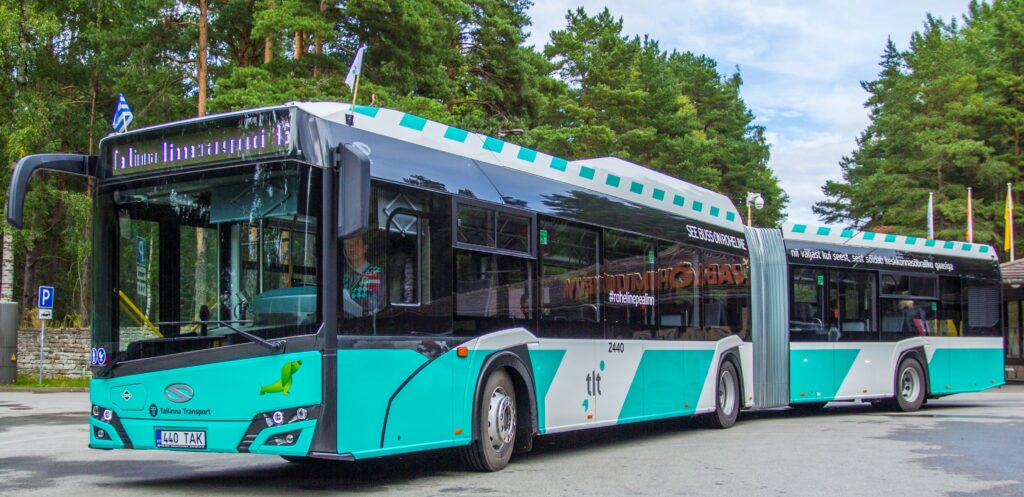We will continue to offer the best service

The corona crisis has left its mark on many areas of life. Public transport in the capital is no exception. Since the first corona outbreak, we have taken special measures to keep our vehicles clean, protecting both passengers and our employees from infection. However, the effective disinfection of vehicles, which requires great attention, and other corona measures have not postponed the implementation of the development strategy of Tallinna Linnatranspordi AS. The first 100 gas buses have appeared on the streets of Tallinn. We have started replacing seat covers on buses, which will create a cleaner environment for passengers. We are preparing for the commissioning of the tram line to the port, and we will stick to the plan to start offering the service from 2035 exclusively with electric city air saving buses running on electricity. We will continue to succeed in the difficult circumstances of the coronary crisis with our main task – to provide fast, convenient, and safe public transport.
The results of the public opinion poll conducted by Turu-uuringute AS, which reflect the impact of the corona crisis on our service and people’s attitudes towards public transport and the company are therefore even more important for us. Ahead of time, we are pleased to confirm that the image of TLT AS is still high, and the service we offer to our citizens is also receiving positive reviews.
About the survey
The survey reflects the attitudes of city dwellers towards the level of public transport. As this was a face-to-face interview that gives the most accurate results, it had to be organized in two sections – the first part 5-12 March and the final round of the survey on 3-14 September, but the veracity of the data received did not suffer from it, but rather added more inciteful information.
Five hundred people from Tallinn participated in the survey, who were divided according to the number of inhabitants of the districts. That was enough to make generalizations. In order to ensure accuracy and the involvement of different population segments, the structure of the survey participants was adjusted to the state statistical data on the gender and age distribution of the population of Tallinn.
At the request of TLT AS, Turu-uuringute AS has been researching the attitudes of public transport users since 1999. In the current decade, satisfaction with Tallinn’s public transport has grown strongly. If in 2010 the TLT service was evaluated with 3.6 points, in 2014 with 3.93 points, then in 2015 it reached 4.13, in 2017 it dropped slightly to 4.12, rising again to 4.13 this year.
City dwellers are satisfied with public transport
76% of city dwellers use public transport, which has slightly decreased compared to the previous survey, but there is nothing unexpected about it, as people move less in the corona crisis. The most popular mode of public transport continues to be the bus, with 36% of daily users.
Satisfaction with Tallinn’s public transport is high. 82% of public transport users are satisfied. The average satisfaction indicator for the organization of public transport is 4.09. Only 4% of the respondents were not at all satisfied with the organization of public transport. At the same time, satisfaction among people who use public transport on a daily basis was as high as 95%. However, young people aged 15-19 praised public transport the most, and 96% of them were completely satisfied.
The survey confirmed that citizens appreciate our company. In the five-point system, we received a high score of 4.13. The innovations that TLT management has come up with in the last year are also supported. 70% of public transport users are in favor of electric buses, which shows the support of the majority of city dwellers for our initiative to switch all bus traffic to electricity by 2035. When testing electric vehicles, we make preparations for this. 67% of city dwellers are in favor of building new tram connections, and 61% are in favor of buses using gas. Here, too, we are pioneers. Thanks to our competence in the field of rail transport, a tram connection to the port will be established in the coming years. In the long run, we are an important partner in the implementation of rail transport developments in Tallinn and Harju County. As for gas buses, the first 100 have taken to the streets and been well received. We will continue to renew the bus fleet with gas vehicles that are sustainable for the urban environment.
In the case of public transport, adherence to the timetable has been considered the most important in the past as well. The case is the same now. Vehicle cleanliness is also important, and we have made significant progress in this area. In corona conditions, it is especially important to clean and repeatedly disinfect the passenger compartment during the day. The replacement of easily soiled textile seat covers with easy-to-clean materials has also made bus travel more pleasant. 77% of city dwellers considered it important in ensuring cleanliness.
The reputation of the TLT remains high in the eyes of passengers. The company is considered to be evolving, up to date, responsive to the needs of passengers, and open.
Buses, trams, and trolleys through the eyes of passengers
Satisfaction with different modes of transport is high among passengers. As many as 87% of users are satisfied with trams, 78% with buses, and 62% with trolleys. The average scores were in a five-point system: tram 4.36, bus 4.1, and trolleys 3.94.
In the case of buses, the good communication of stop information and adherence to the timetable were assessed. In the case of the tram, the announcement of stops, adherence to the timetable, and the stability of the timetable were also highly valued. In the case of trolleys, people are satisfied with the availability of information, the announcement of stops, and the location of stops, which received a positive assessment. In terms of cleanliness, users consider the tram to be the best, and 80% are satisfied with it, followed by the bus, with 73% of users being satisfied.
Who are the users of Tallinn public transport
The survey also gives an idea of which districts public transport is most used.
58% of the users of public transport live in North Tallinn, 54% in Mustamäe and 47% in Lasnamäe, and 24% in the city center. Women use public transport more often than men, and the youngest (15-19) and oldest (+74) use public transport the most.
Changes in public transport
It is particularly gratifying that more than half of the respondents answered positively to the question of whether riding in public transport has become more pleasant during the last year. This gives us the courage to move forward with the changes started by TLT. Every day passengers rated the improvement of the service higher than last year, and they already know what to evaluate. 60% of city dwellers who use the bus every day confirmed that the ride has become more pleasant in the last year.
Preference for means of transport
62% of respondents prefer a bus as a means of transport. However, there are small differences in age. While younger and middle-aged people prefer to take a tram, older people prefer to take a bus.
The study also revealed the following paradox: everyday passengers prefer a bus to the same destination, while rare public transport users prefer to take a tram and trolley.
The preference for means of transport also varies from city district to city district: Northern Tallinn – tram 52%, Haabersti – bus 72%, City Center – tram 69%, Kristiine – tram 48%, Lasnamäe – bus 88%, Mustamäe – bus 63% and Nõmme – bus 57%.
Comparison with other countries
For the first time, we asked the question, what does Tallinn’s public transport look like compared to other cities? Some of the respondents did not answer because they apparently did not have the relevant experience, but as many as 29% rated Tallinn’s public transport as better and only 7% as worse compared to cities in other countries. Younger people, in particular, rated Tallinn’s public transport organization positively. One of the respondents stated that better than public transport in Tallinn could only be found in Japan.
When would the private car be exchanged for public transport
When curbing car use, it is important to know what would make existing car users take their journeys on public transport. Here, too, the survey provided an answer. Only 22% of car owners said they would not be removed from behind the steering wheel under any circumstances. 37% of car users promised to seriously consider switching to public transport if there were fewer transfers on their daily journey, 21% would switch to a bus or tram if the intervals were shorter, and 20% if the stop was closer to home.
We need to take this into account in future development plans, because of the greater the number of public transport users, the cleaner the urban air and the fewer congestions.
Turu-uuringute AS has done a great job in finding out the expectations of the citizens. Our task is to develop Tallinn’s public transport exactly as the citizens want to see, taking into account the expectations of the citizens.

